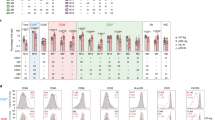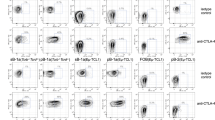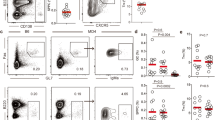Abstract
Models of B-cell development in the immune system suggest that only those immature B cells in the bone marrow that undergo receptor editing express V (D)J -recombination-activating genes (RAGs)1,2,3. Here we investigate the regulation of RAG expression in transgenic mice carrying a bacterial artificial chromosome that encodes a green fluorescent protein reporter instead of RAG2 (ref. 4). We find that the reporter is expressed in all immature B cells in the bone marrow and spleen. Endogenous RAG messenger RNA is expressed in immature B cells in bone marrow and spleen and decreases by two orders of magnitude as they acquire higher levels of surface immunoglobulin M (IgM). Once RAG expression is stopped it is not re-induced during immune responses. Our findings may help to reconcile a series of apparently contradictory observations, and suggest a new model for the mechanisms that regulate allelic exclusion, receptor editing and tolerance.
This is a preview of subscription content, access via your institution
Access options
Subscribe to this journal
Receive 51 print issues and online access
$199.00 per year
only $3.90 per issue
Buy this article
- Purchase on Springer Link
- Instant access to full article PDF
Prices may be subject to local taxes which are calculated during checkout




Similar content being viewed by others
References
Gay, D., Saunders, T., Camper, S. & Weigert, M. Receptor editing: an approach by autoreactive B cells to escape tolerance. J. Exp. Med. 177, 999–1008 (1993).
Tiegs, S. L., Russell, D. M. & Nemazee, D. Receptor editing in self-reactive bone marrow B cells. J. Exp. Med. 177, 1009–1020 (1993).
Grawunder, U.et al. Down-regulation of RAG1 and RAG2 gene expression in preB cells after functional immunoglobulin heavy chain rearrangement. Immunity 3, 601–608 (1995).
Yang, X. W., Model, P. & Heintz, N. Homologous recombination based modification in Escherichia coli and germline transmission in transgenic mice of a bacterial artificial chromosome. Nature Biotechnol. 15, 859–865 (1997).
Lin, W. C. & Desiderio, S. Regulation of V(D)J recombination activator protein RAG-2 by phosphorylation. Science 260, 953–959 (1993).
Allman, D. M., Ferguson, S. E. & Canero, M. P. Peripheral B cell maturation. I. Immature peripheral B cells in adults are heat-stable antigenhi and exhibit unique signaling characteristics. J. Immunol. 149, 2533–2540 (1992).
Rolink, A. G., Andersson, J. & Melchers, F. Characterization of immature B cells by a novel monoclonal antibody, by turnover and by mitogen reactivity. Eur. J. Immunol. 28, 3738–3748 (1998).
Han, S., Zheng, B., Schatz, D. G., Spanopoulou, E. & Kelsoe, G. Neoteny in lymphocytes: Rag1 and Rag2 expression in germinal center B cells. Science 274, 2094–7 (1996).
Hikida, M.et al. Reexpression of RAG-1 and RAG-2 genes in activated mature mouse B cells. Science 274, 2092–2094 (1996).
Hertz, M., Kouskoff, V., Nakamura, T. & Nemazee, D. V (D)J recombinase induction in splenic B lymphocytes is inhibited by antigen-receptor signalling. Nature 394, 292–295 (1998).
Meffre, E.et al. Antigen receptor engagement turns off the V(D)J recombination machinery in human tonsil B cells. J. Exp. Med. 188, 765–772 (1998).
Forster, I. & Rajewsky, K. The bulk of the peripheral B-cell pool in mice is stable and not rapidly renewed from the bone marrow. Proc. Natl Acad. Sci. USA 87, 4781–4784 (1990).
Papavasiliou, F.et al. V(D)J recombination in mature B cells a new mechanism for diversification of antibody responses. Science 278, 298–301 (1997).
Russell, DM.et al. Peripheral deletion of self-reactive B cells. Nature 354, 308–311 (1991).
Hartley, S. B.et al. Elimination from peripheral lymphoid tissues of self-reactive B lymphocytes recognizing membrane-bound antigens. Nature 353, 765–769 (1991).
Pelanda, R.et al. Receptor editing in a transgenic mouse model: site, efficiency, and role in B cell tolerance and antibody diversification. Immunity 7, 765–775 (1997).
Han, S.et al. V(D)J recombinase activity in a subset of germinal center B lymphocytes. Science 278, 301–305 (1997).
von Boehmer, H. & Fehling, H. J. Structure and function of the pre-T cell receptor. Annu. Rev. Immunol. 15, 433–452 (1997).
Turka, L. A.et al. Thymocyte expression of RAG-1 and RAG-2; termination by T cell receptor cross-linking. Science 253, 778–781 (1991).
Colcclough, C., Perry, R. P., Karjalainen, K. & Weigert, M. Aberrant rearrangements contribute significantly to the allelic exclusion of immunoglobulin gene expression. Nature 290, 372–378 (1981).
Storb, U. in Immunoglobulin Genes (eds Honjo, T. & Alt, F.) 345–363 (Academic, San Diego, 1995).
Melamed, D., Benschop, R. J., Cambier, J. C. & Nemazee, D. Developmental regulation of B lymphocyte immune tolerance compartmentalizes clonal selection from receptor selection. Cell 92, 173–182 (1998).
Hartley, S. B.et al. Elimination of self-reactive B lymphocytes proceeds in two stages: arrested development and cell death. Cell 72, 325–335 (1993).
Chen, C.et al. The site and stage of anti-DNA B-cell deletion. Nature 373, 252–255 (1995).
Nussenzweig, M. C.et al. Ahuman immunoglobulin gene reduces the incidence of lymphomas in c -Myc-bearing transgenic mice. Nature 336, 446–450 (1988).
Costa, T. E. F., Suh, H. & Nussenzweig, M. C. Chromosomal position of rearranging gene segments influences allelic exclusion in transgenic mice. Proc. Natl Acad. Sci. USA 89, 2205–2208 (1992).
Kitamura, D., Roes, J., Kuhn, R. & Rajcwsky, K. AB-cell deficient mouse by targeted disruption of the membrane exons of the immunoglobulin µ-chain gene. Nature 350, 423–426 (1991).
Schatz, D. G., Oettinger, M. A. & Baltimore, D. The V(D)J recombination activating gene, RAG-1. Cell 59, 1035–1048 (1989).
Oettinger, M. A., Schatz, D. G., Gorka, C. & Baltimore, D. RAG-1 and RAG-2, adjacent genes that synergistically activate V(D)J recombination. Science 248, 1517–1523 (1990).
Schlissel, M., Constantinesc, U. A., Morrow, T., Baxter, M. & Peng, A. Double-strand signal sequence breaks in V(D)J recombination are blunt, 5′-phosphorylated, RAG-dependent, and cell cycle regulated. Genes Dev. 7, 2520–2532 (1993).
Acknowledgements
We thank R. Monroe, C. Seidel and F. Alt for discussing unpublished data; P. Cortes for discussion and anti-RAG2 polyclonal antibodies; N. Heintz and W. Yang for help with BAC technology; and F. Isdell and M. Genova for cell sorting. W.Y. was supported by the NIH, the Surdna Foundation and the William Randolph Hearst Foundation. This work was funded in part by grants from the NIH to M.C.N.
Author information
Authors and Affiliations
Corresponding author
Rights and permissions
About this article
Cite this article
Yu, W., Nagaoka, H., Jankovic, M. et al. Continued RAG expression in late stages of B cell development and no apparent re-induction after immunizion. Nature 400, 682–687 (1999). https://doi.org/10.1038/23287
Received:
Accepted:
Issue Date:
DOI: https://doi.org/10.1038/23287
This article is cited by
-
The alarmin IL33 orchestrates type 2 immune-mediated control of thymus regeneration
Nature Communications (2023)
-
How autoreactive thymocytes differentiate into regulatory versus effector CD4+ T cells after avoiding clonal deletion
Nature Immunology (2023)
-
Eomes identifies thymic precursors of self-specific memory-phenotype CD8+ T cells
Nature Immunology (2020)
-
B7-CD28 co-stimulation modulates central tolerance via thymic clonal deletion and Treg generation through distinct mechanisms
Nature Communications (2020)
-
Myc controls a distinct transcriptional program in fetal thymic epithelial cells that determines thymus growth
Nature Communications (2019)
Comments
By submitting a comment you agree to abide by our Terms and Community Guidelines. If you find something abusive or that does not comply with our terms or guidelines please flag it as inappropriate.



